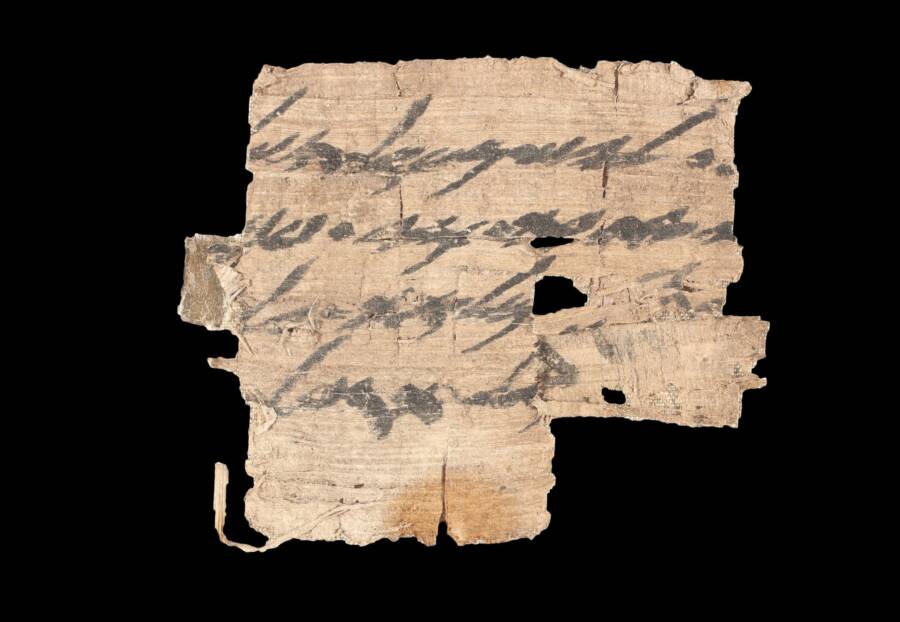This tiny papyrus fragment is 2,700 years old and is one of just three that has ever been discovered from the First Temple Period.

Israel Antiquities Authority/FacebookAnalysis of the fragment confirmed that it dates back to the late seventh or early sixth century B.C.E.
A lost fragment of the Dead Sea Scrolls has been found in an unlikely place — Montana. For almost 60 years, it hung in the home of an American woman who’d acquired the treasure during a trip to Israel.
According to the Daily Mail, Ben-Gurion University Professor Shmuel Ahituv became aware of the existence of the rare fragment while working to complete the book of her late colleague, Ada Yardeni, who studied ancient Hebrew script. The Times of Israel reports that Ahituv then alerted Eitan Klein, the head of the Israel Antiquities Authority’s Theft Prevention Unit.
Through some old-fashioned detective work, Klein was able to track down the son of the fragment’s original owner, who wishes to remain anonymous. According to the Times of Israel, he told Klein that his mother had picked up the fragment during a visit to Israel in 1965. Part of a Christian mission, she worked with a number of people associated with the Dead Sea Scrolls and somehow acquired a fragment that she brought home and framed.
After making contact, the Israel Antiquities Authority suggested that the fragment’s current owner bring the scroll to Israel. He visited the organization’s Judean Desert Scroll Department’s Conservation Laboratory in Jerusalem and agreed to donate the tiny rare fragment of papyrus.
“Returning this document to Israel is part of our ongoing efforts … to protect and preserve the cultural heritage of the State of Israel, a heritage that belongs to all its citizens,” Klein said, according to an Israel Antiquities Authority Facebook post about the lost Dead Sea scroll fragment.
So what exactly did this rare piece of papyrus say?

Israel Antiquities Authority/FacebookThe parchment contains just a fragment of a phrase, albeit with religious significance.
According to Newsweek, the parchment — which epigraphical analysis as well as carbon-dating revealed was from the late seventh or early sixth-century B.C.E., toward the end of the Kingdom of Judah — bears a simple, cut-off message. Addressed to or from “Ishmael” and written in ancient Hebrew script, it reads, “Don’t send to …” and, “of no help.”
Israel Antiquities Authority notes on Facebook that the name “Ishmael” was commonly used in ancient times. And Ahituv further explained to the Times of Israel that the parchment appears to be part of a larger list of instructions for someone to send and not send certain items.
“It’s a simple letter with an order,” Ahituv explained. “He’s told, ‘Don’t send.’ What not to send? I don’t know. And ‘of no help’ is written later. What’s of no help?! We don’t know.” Ahituv added that the letter appeared hastily written, noting: “He writes as we write. He dips his stylus in ink, and writes.”

Israel Antiquities Authority/FacebookResearchers are thrilled to have recovered the fragment, which they believe belongs in Israel.
Regardless of its simple — and incomplete — message, scholars are absolutely thrilled with the discovery, as the parchment found in Montana is just one of three known to exist from the First Temple Period. That period, from 970 to 586 BCE, marks the construction and destruction of the Temple of Solomon in Jerusalem.
“Towards the end of the First Temple period, writing was widespread,” Joe Uziel, director of the Judean Desert Scrolls Unit, explained according to the Daily Mail. “However, First Temple-period documents written on organic materials – such as this papyrus – have scarcely survived.”
According to the Times of Israel, there are currently some 25,000 Dead Sea Scroll fragments in the lab, which belong to hundreds of different manuscripts. Since papyri during the First Temple Period rarely survived, most are from the Second Temple Period (516 BCE to 70 C.E.).
For now, the rare Dead Sea Scroll fragment will be carefully preserved for future study. Happily, according to Klein, it made its way back to Israel after almost 60 years, where it belongs.
“The legal and worthy place for this artifact is in the IAA Dead Sea Scrolls Unit,” he said according to the Daily Mail, “and we are making every effort to retrieve additional fragmentary scrolls located abroad, and to bring them to Israel.”
After reading about the lost fragment of the Dead Sea scrolls discovered in Montana, learn about the scrolls discovered buried in ash during the eruption of Mount Vesuvius in 79 C.E., which scientists are hoping to read with A.I. technology. Or discover the story of the previously unknown Van Gogh portrait found beneath another painting.





